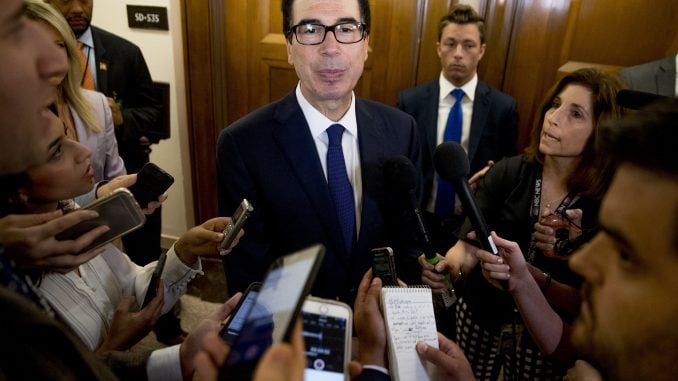
WASHINGTON — The Trump administration has unveiled its plan for ending government control of Fannie Mae and Freddie Mac, the two giant mortgage finance companies that nearly collapsed in the financial crisis 11 years ago and were bailed out at a total cost to taxpayers of $187 billion.
Treasury Secretary Steven Mnuchin and Housing and Urban Development Secretary Ben Carson, along with regulator Mark Calabria, director of the Federal Housing Finance Agency, testified Tuesday before the Senate Banking Committee on the plan for returning Fannie and Freddie to private ownership. The companies have become profitable again and have fully repaid their bailouts. Under the plan, the companies would be privately owned, government “sponsored” entities, and their profits would no longer go to the Treasury but instead be used to build up their capital bases as a cushion against possible future losses.
The administration’s plan calls for returning Fannie and Freddie to private ownership and reducing risk to taxpayers while seeking to preserve homebuyers’ access to 30-year, fixed-rate mortgages, a pillar of housing finance. The Treasury Department published the plan last week and submitted it to President Donald Trump, who called for it in March.
While not prominently in the public eye, the two companies perform a critical role in the housing market. Together they guarantee roughly half of the $10 trillion U.S. home loan market.
Fannie and Freddie, operating under so-called government conservatorships, have become profitable again in the years since the 2008 rescue and have repaid their bailouts in full to the Treasury.
The plan “would preserve the longstanding government support of the 30-year, fixed-rate mortgage loan,” Mnuchin said Tuesday. “That support, however, should be explicitly defined, tailored and paid for.”
Mnuchin acknowledged that for prices of 30-year mortgages to remain close to current market levels, some level of government support would be needed. He said Congress should authorize an explicit, paid-for guarantee “backed by the full faith and credit of the federal government” for qualified mortgages. The guarantee also should be available to competitors of Fannie and Freddie as mortgage financers, he said.
The administration initially looked to Congress for legislation to overhaul the housing finance system and return the companies to private shareholders. But Congress hasn’t acted, and now officials say they will take administrative action for the core change, ending the Fannie and Freddie conservatorships. They haven’t given a timeline for the administrative action.
“The Trump plan will make mortgages more expensive and harder to get,” said Sen. Sherrod Brown of Ohio, the committee’s senior Democrat.
A flashpoint came over the issue of affordable housing. Fannie and Freddie currently have mandated targets for helping low-income and minority borrowers to buy homes.
Sen. Mike Crapo, R-Idaho, the panel’s chairman, has previously proposed legislation to overhaul the housing finance system. He said at the hearing that the administration’s plan is close to his proposal, but “my strong preference remains to fix it through comprehensive legislation.”
Sen. John Kennedy, R-La., implored the officials to put a proposal before Congress. “This whole thing is a car wreck; it’s a dumpster fire,” Kennedy said. Put it before the committee, “and let senators be senators.”
Before the Great Depression of the 1930s, financing for mortgages was mainly provided by life insurance companies, banks and thrifts, with little government support. Fannie was created in 1938 to buy loans issued by the Federal Housing Administration. Freddie was established in 1989.
They are called government-sponsored enterprises. Before they were taken over in 2008, they were private companies but still enjoyed an implicit guarantee that the government would step in and rescue them if they failed.
That’s what happened after the collapse of the housing market and the wave of mortgage defaults.
The companies don’t make home loans. They buy them from banks and other lenders, and bundle them into securities, guarantee them against default and sell them to investors. Because the companies are under government control, investors are eager to snap up the “safe” securities.
Administration officials say the government should have only a limited role in housing finance, and that the current system leaves taxpayers exposed to potential bailouts again. Some lawmakers, both Republicans and Democrats, agree with that view.
Senior Treasury officials told reporters last week that the government’s far-reaching power in this area means the Federal Housing Finance Agency can determine who gets a home mortgage, the price and terms of the loan, how it is made and then serviced and what happens if a borrower defaults.
Experts say changes are unlikely anytime soon, and likely after 2020. Some conditions will have to be met for the companies to be deemed ready for privatization. They include ensuring the companies have sufficient capital to operate, and to continue on their own in the event of a severe economic downturn.
Other changes outlined in the plan would have to be approved by Congress. They include replacing Fannie and Freddie’s affordable housing goals with the intended “tailored support” for first-time homebuyers and low- and moderate-income borrowers.
Administration officials acknowledge it’s hard to predict what the impact on borrowing costs would be. But they maintain that by removing government restrictions, the plan would likely expand the supply of mortgages and possibly lower costs.
